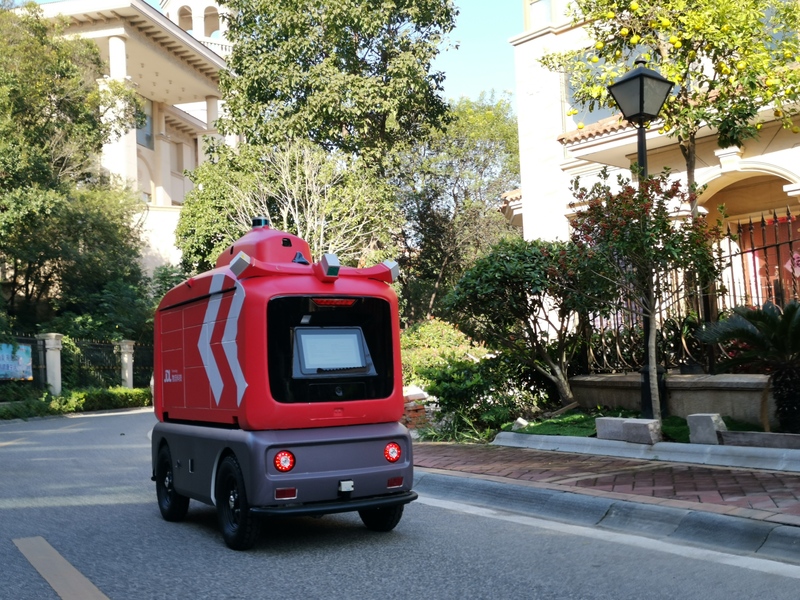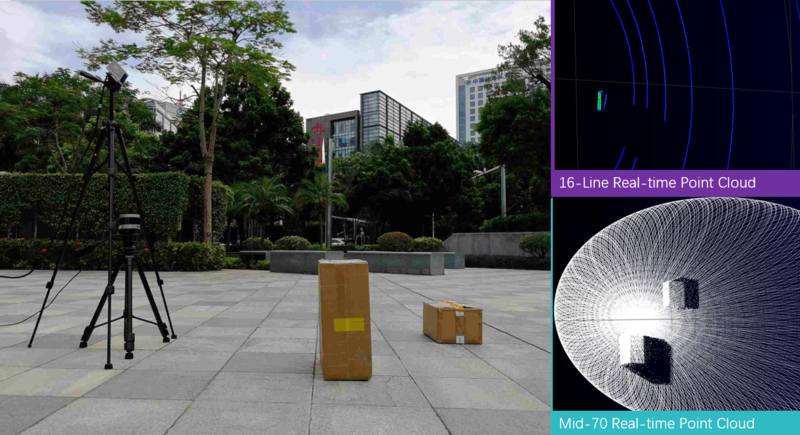Customer Success Story
The Future Has Arrived: Livox Helps JD Logistics Build Its L4 Driverless Delivery System
2020-12-01Through continuous innovation, Livox has broken through the three major bottlenecks of the LiDAR industry, i.e., mass production, reliability and cost. We will continue to launch more cost-effective products for the benefits of various industry segments and work with our partners to inaugurate the era of spatial intelligence.

JD L4 unmanned delivery robot equipped with Livox Mid-70 LiDAR.
As a global leader in the logistics field, JD Logistics is committed to developing its own latest logistics products and solutions so as to promote the intelligent development of the global supply chains. With the efficiency significantly improved by unmanned delivery vehicles, the deliverymen can have more energy for business innovation and expansion, and provide more considerate and personalized services for users along with higher personal income. In this way, a virtuous cycle of technological innovation and service development is formed, and Livox has done its part to accelerate the launch of unmanned delivery vehicles.
The Future Has Arrived
In October, the first batch of some 10 JD unmanned delivery vehicles were officially put into daily operation in Changshu, Jiangsu. Unlike common unmanned delivery vehicles, the JD logistics vehicles are equipped with a 3D spatial environment interactive sensor, i.e., the Livox Mid-70 LiDAR system. With its ample FOV, this system can easily perceive its surrounding environment. Through simple assembly and installation, it can realize 100% coverage without blind spots, improving overall safety and operational efficiency of the system. Besides, its hardware cost is below 50% of that of traditional solutions, allowing large-scale commercial deployment.

Figure 2: An unmanned delivery vehicle runs on road in Changshu
Technical Analysis of Perception Solutions for Logistics Vehicles
To perform delivery tasks efficiently, the unmanned delivery vehicles must navigate complex road environments, including public roads, parks, and residential communities. Therefore, 360° perception is required for safe system operations.
To perceive the surrounding environments, the unmanned delivery vehicles available on the market generally adopts multiple traditional 16-line LiDAR and other single-line sensors, such as laser sensors, ultrasonic sensors, and binocular camera sensors on the roof and body. However, due to FOV and accuracy issues, it is still difficult for them to achieve accurate 100% coverage without blind spots.
Through the simulation of the installation height (approximately 0.6 meters) of a traditional 16-line mechanical LiDAR for blind spot coverage, you can see that there is a blind zone of nearly 2 meters due to a vertical FOV of only 30°. As shown by the real-time point cloud in the figure below, even if there is a 0.5m-tall large box put 1.1m away, the 16-line LiDAR can only detect a small portion, while a small box 1.8m away is not detected at all. This is also the reason why traditional robot solutions have to adopt single-line radar and ultrasonic sensors to cover the blind spots, which increases overall hardware costs.

Figure 3: Simulated obstacles - large box (47*37*18 cm) at 1.1m and small box (20*34*26 cm) at 1.8 m
It is amazing that the Livox Mid-70 system fills this gap. With a 70° vertical FOV of and only 5cm near-field blind zone, Mid-70 enables 100% coverage without blind spots when embedded in a vehicle. As shown in the point cloud chart in Figure 3, the simulating installation with a height of 1.4 m and a downward slope of 47°, the Mid-70 solution allows precise coverage without blind spots, greatly improving the overall environmental perception of the system and reducing hardware cost.

Figure 4: Comparison of Blind Spots of Traditional LiDAR and Mid-70
In addition to 100% forward sensing coverage with a single Mid-70, multiple Mid-70 sensors can be connected in series for 100% coverage without blind spots around the entire vehicle body.

Figure 5: Example of complete forward and lateral coverage with 3 Mid-70 sensors
Guarantee for Stable Mass Production
In addition to the performance and cost advantages of the Mid-70, stable mass production capacity is another key factor in the partnership between Livox and JD Logistics. Leveraging the great supply chain advantages, production capacity, and quality control system of its parent company, DJI, Livox quickly stands out from its peers and becomes a major force for the large-scale commercialization of autonomous driving. In this July, Livox and Shanghai Gaussian Automation Development Co.,Ltd signed a contract of 10,000 LiDAR system, which is a milestone in the low-speed autonomous driving field.
Through continuous innovation, Livox has broken through the three major bottlenecks of the LiDAR industry, i.e., mass production, reliability and cost. We will continue to launch more cost-effective products for the benefit of various industry segments and work with our partners to inaugurate the era of spatial intelligence.